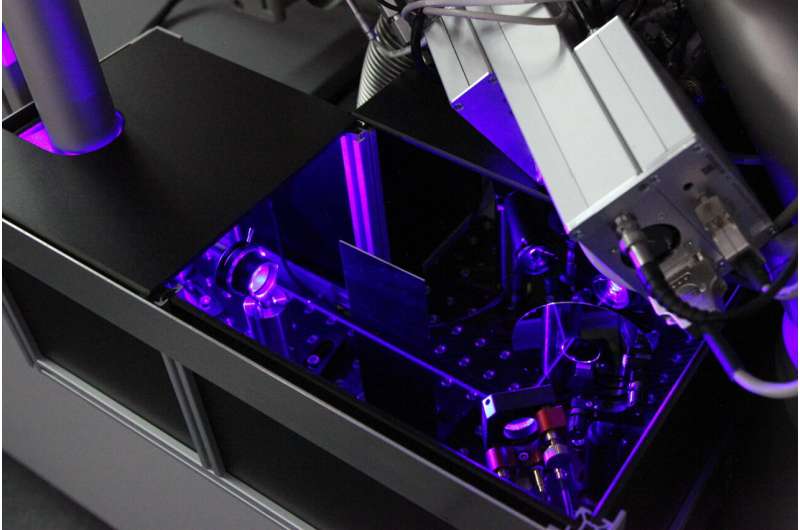New technique provides detailed information on nuclear material

Whether soil contaminated with nuclear material or archaeological finds: Analyzing isotopes can help determining the age and origin of a sample very accurately. Researchers from Leibniz University Hannover (LUH) and Johannes Gutenberg University Mainz (JGU) have now developed a new technique suitable for obtaining information on the origin of microparticles by analyzing isotope distributions. The project was funded by the Federal Ministry of Education and Research (BMBF) and the Siebold Sasse Foundation by more than two million euros. Their findings have now been published in Science Advances.
The method was developed for nuclear forensics, thus, for nuclear material. Eventually, the method might be applied to non-nuclear samples, such as when determining the origin of samples via isotope distributions in archaeology, food or environmental pollutants. “Our method leaves microscopic particles virtually intact. In ideal settings, we only count several 10,000 ions. This enables us to conduct further studies with different techniques or, for example, conserve the sample as evidence,” explains project manager Prof. Dr. Clemens Walther from the Institute of Radioecology and Radiation Protection at LUH.
SNMS (resonant lasersecondary neutral mass spectrometry) provides insights into the origin and genesis of materials through measurements of their elemental and isotopic composition. For example, if material originates from a nuclear reactor, this allows researchers to draw conclusions about the type of reactor and its operating conditions, or to determine how long the material remained inside of the reactor (burnup). With this method, almost all elements can be identified. The research team focuses on the actinides uranium, plutonium, americium and curium, as well as fission products such as strontium, caesium or technetium. The publication demonstrates the capabilities of the method by investigating particles from Chernobyl released during the 1986 reactor explosion.
In contrast to conventional methods, SNMS mostly works in a quasi non-destructive manner. Therefore, the particle is available for further studies. For this purpose, a commercial TOF-SIMS finstrument (static secondary ion mass spectrometry) is combined with lasers in order to ionize various elements selectively. Unlike standard mass spectrometry methods, this technique suppresses isobars, therefore allowing to distinguish between elements such as uranium or plutonium, that have isotopes with the same mass, with an advantage over conventional mass spectrometers.
The same applies to the elements plutonium and americium. This is of great interest, since 241Pu has a half-life of only 14 years, decaying into 241Am. As an alpha emitter, 241Am is highly radiotoxic and will become the predominating alpha exposure (radioactive contamination) in the Chernobyl area in a few years. In order to use and deal with contaminated areas in the future, it is vital to know how quickly and which isotopes can be released from particles that are present in large quantities.
Since the method does not require extensive sample preparation, such as chemical separation, researchers are able to identify a particle, separate it and measure isotope patterns of up to four different elements within one working day. Due to these features, this is a one-of-a-kind facility.
Members of the Quantum/LARISSA work group at the JGU Institute of Physics have contributed their expertise in several contexts with regard to experimental foundations of the trace analysis method used in the project. The laser system was developed at the Institute of Physics in Mainz and implemented into the analytical measuring system in Hannover. Moreover, optical excitation and ionization steps for the environmentally relevant actinides plutonium, americium and curium were tested via the laser mass spectrometry equipment of JGU while characterizing their suitability for spatially resolved analytics at the Institute of Radioecology and Radiation Protection.
Prof. Dr. Klaus Wendt, head of the work group, adds: “Working with the Institute of Radioecology and Radiation Protection has been particularly fruitful since this allowed us to contribute our fundamental research approaches in order to identify ultratrace elements. Together, we are now able to identify hazardous radionuclides—even in very small quantities on minuscule particles.”
Their findings have now been published in Science Advances, titled “New horizons in microparticle forensics: Actinide imaging and detection of 238Pu and 242mAm in hot particles.”
Quick detection of uranium isotopes helps safeguard nuclear materials
Hauke Bosco et al, New horizons in microparticle forensics: Actinide imaging and detection of 238 Pu and 242m Am in hot particles, Science Advances (2021). DOI: 10.1126/sciadv.abj1175
Provided by
Leibniz Universität Hannover
Citation:
New technique provides detailed information on nuclear material (2021, November 2)
retrieved 2 November 2021
from https://phys.org/news/2021-11-technique-nuclear-material.html
This document is subject to copyright. Apart from any fair dealing for the purpose of private study or research, no
part may be reproduced without the written permission. The content is provided for information purposes only.
For all the latest Science News Click Here
For the latest news and updates, follow us on Google News.

